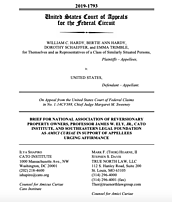Railroad lines once extended throughout the United States. At the peak in 1916, more than 270,000 miles of track crisscrossed the country. As railroads became less popular, however, thousands of miles of rail lines were left unused. Since the 1980s, the Rails-to-Trails Act has converted former rail lines into hiking and biking trails. But many of those rail lines were originally easements across private property. Under common-law doctrine, when an easement is abandoned and no longer used for the original purpose, the land “reverts” back to the property over which the easement was granted. Therefore, if the government wants to use part of an abandoned rail line for a trail, it needs to pay for the land under the Takings Clause of the Fifth Amendment.
In 1890, the previous owners of the plaintiffs’ property conveyed an easement over their land to the Middle Georgia & Atlantic Railway Company to lay and operate a rail line across the property. In 2013, the federal Surface Transportation Board granted Norfolk & Southern’s (the original railway company’s successor) petition to abandon the fifteen-mile stretch. After granting the request, the Board invoked the Rails-to-Trails Act and transferred the abandoned right-of-way easement to the Newton County Trail Path Foundation, which intends to use the easement for a public recreation trail. The Hardys and other property owners challenged the transfer as a taking of their property and thus they were owed compensation. The Court of Federal Claims agreed, and the government appealed.
Cato has joined the National Association of Reversionary Property Owners, the Southeastern Legal Foundation, and renowned property law professor James W. Ely Jr. in an amicus brief urging the appellate court to affirm the lower court ruling. We argue that under state-law principles—which even in the federal eminent domain context govern the disposition of property interests—an easement, once abandoned, reverts to the landowners and re-merges into their property. If the federal government wishes to convey the railway’s abandoned easement to the Foundation, it cannot, therefore, rely on the 1890 conveyance. Rather, it must “take” the easement through a new eminent domain action and pay owners just compensation.
In a case citing Supreme Court precedent, the Tenth Circuit held “[i]t is settled law that a Fifth Amendment taking occurs in Rails-to-Trails cases when government action destroys state-defined property rights by converting a railway easement to a recreational trail, if trail use is outside the scope of the original railway easement.” This reasoning applies to this case. Georgia law in 1890 clearly limited the conveyed easement to use as a railway, not as a recreational trail. And this statutory design is by no means unique to Georgia, with several state supreme courts offering the same or similar readings of their state laws.
The Rails-to-Trails Act does not give the federal government carte blanche to convert railroad right-of-way easements into recreational trails or other public uses. When the federal government invokes the act to repackage abandoned rail lines, it must do so in a manner that respects existing state property laws. Here, the plaintiffs simply seek just compensation for a new use unauthorized and not contemplated under the original easement. The Federal Circuit should affirm the lower court or countless property owners will be subject to a rails-to-trails program that has, well, gone off the rails.




